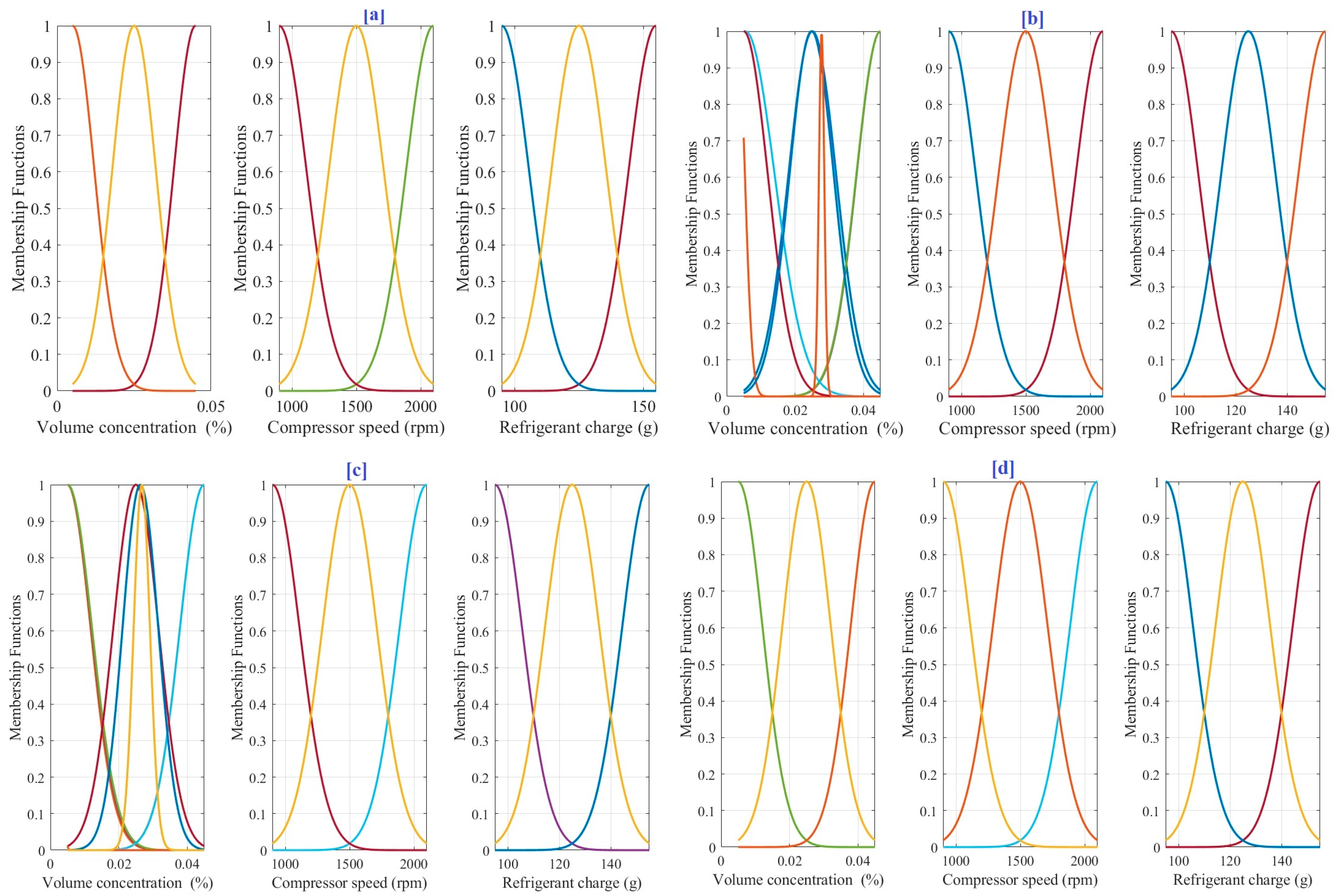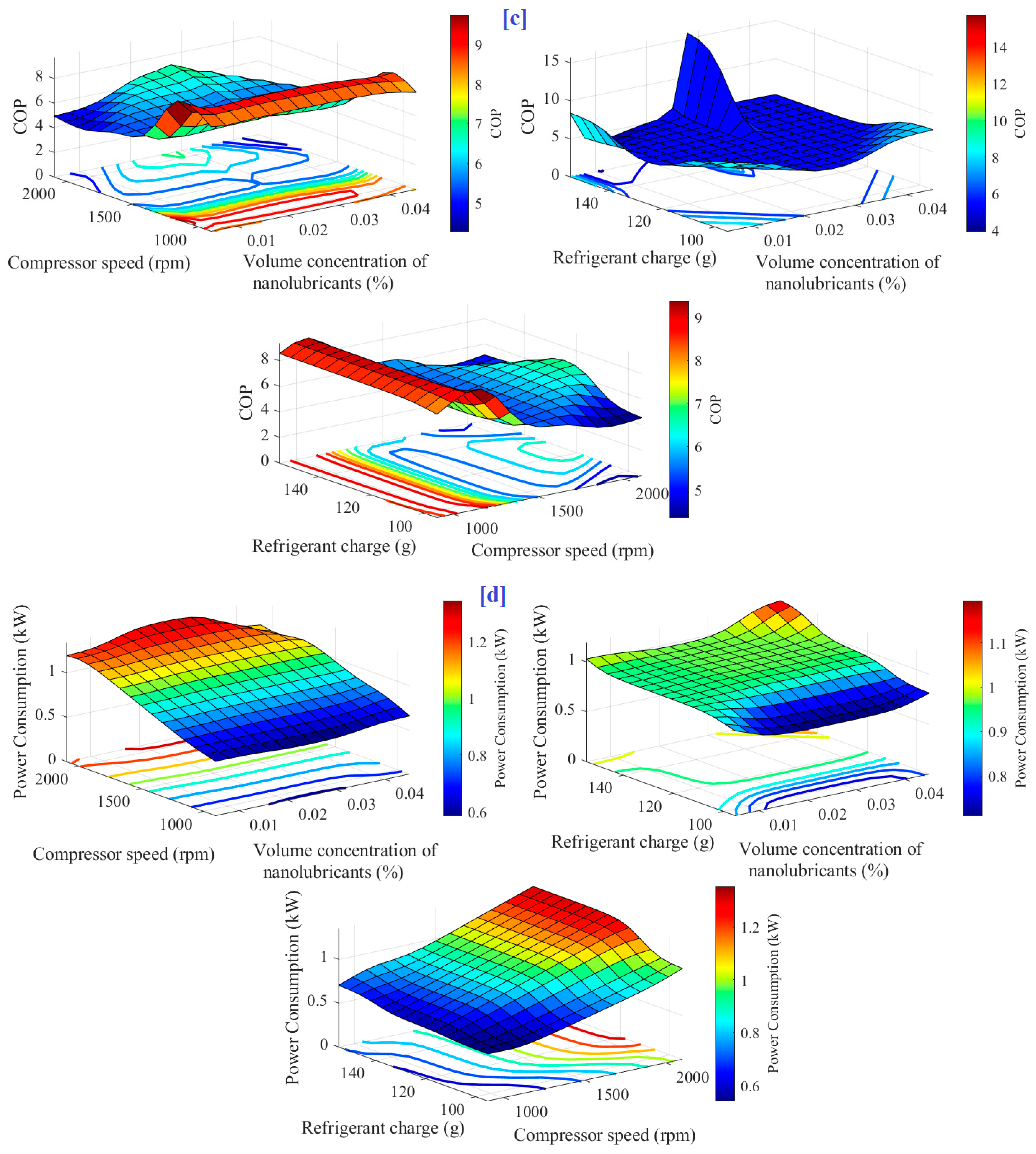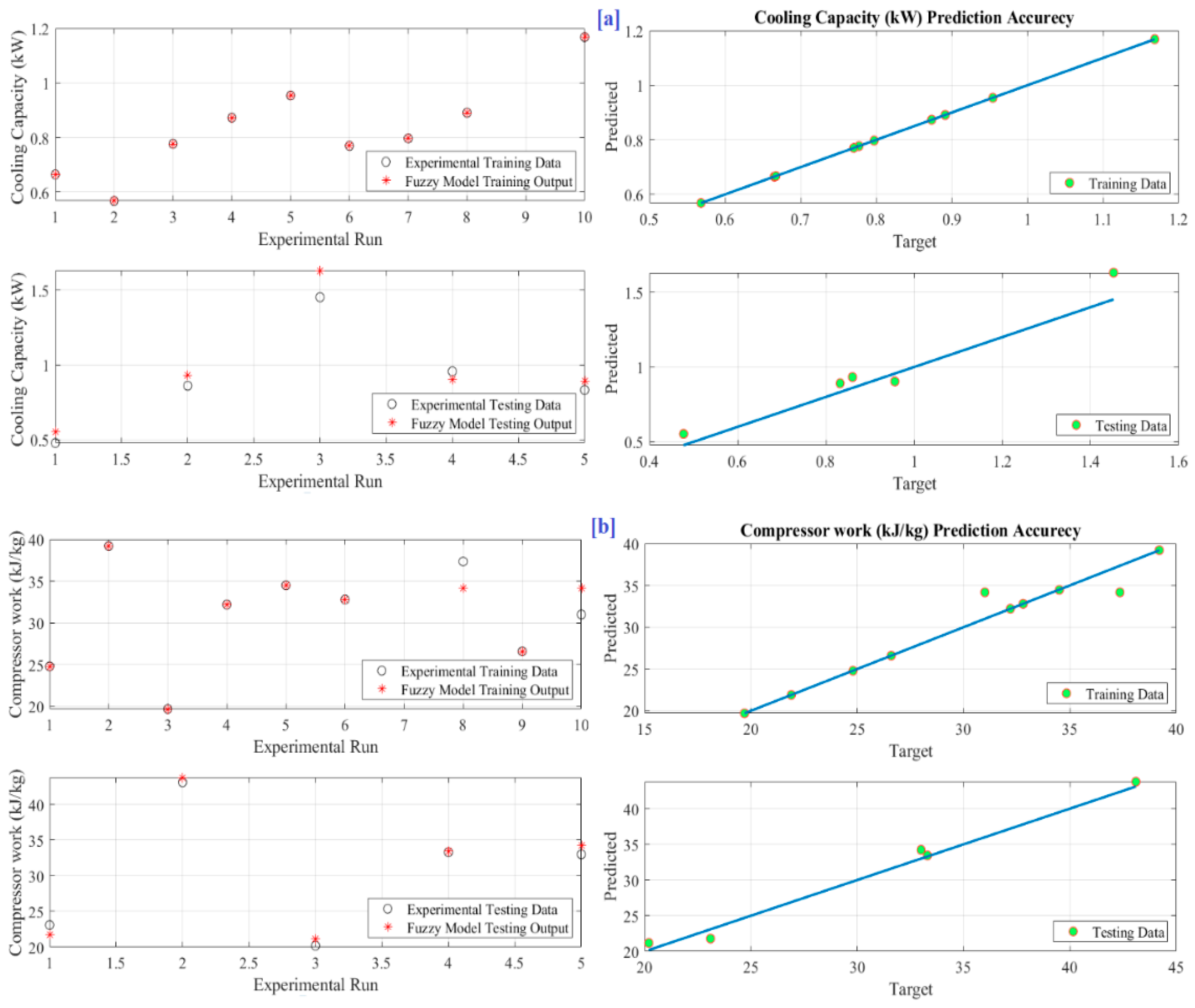Improving Automotive Air Conditioning System Performance Using Composite Nano-Lubricants and Fuzzy Modeling Optimization
Abstract
:1. Introduction
2. Data Set
3. Modeling and Optimization
3.1. Fuzzy Model
3.2. Marine Predators Algorithm (MPA)
4. Results and Discussion
4.1. Modeling Phase
4.2. Optimization Phase
5. Conclusions
Author Contributions
Funding
Institutional Review Board Statement
Informed Consent Statement
Data Availability Statement
Acknowledgments
Conflicts of Interest
References
- Diga, D.; Severin, I.; Ignat, N.D. Quality Study on Vehicle Heat Ventilation and Air Conditioning Failure. Sustainability 2021, 13, 13441. [Google Scholar] [CrossRef]
- Patel, H.N.; Modi, K.V. Recent Advances in Performance Enhancement Techniques and the Perspective of Solar Energy for Automobile Air-Conditioning System—A Critical Review. Sol. Energy 2022, 241, 184–219. [Google Scholar] [CrossRef]
- Xie, Y.; Yang, P.; Qian, Y.; Zhang, Y.; Li, K.; Zhou, Y. A Two-Layered Eco-Cooling Control Strategy for Electric Car Air Conditioning Systems with Integration of Dynamic Programming and Fuzzy PID. Appl. Therm. Eng. 2022, 211, 118488. [Google Scholar] [CrossRef]
- IAE. Cooling on the Move: The Future of Air Conditioning in Vehicles; IAE: Paris, France, 2019. [Google Scholar]
- Vashisht, S.; Rakshit, D. Recent Advances and Sustainable Solutions in Automobile Air Conditioning Systems. J. Clean. Prod. 2021, 329, 129754. [Google Scholar] [CrossRef]
- Khaled, M.B.; Qandil, A.; Abdallatif, N.; Beithou, N.; Alsaqoor, S.; Alahmer, A.; Aybar, H.Ş.; Andruszkiewicz, A. Heating and Cooling Device for Motorhomes and Caravans. Int. J. Thermofluids 2022, 15, 100193. [Google Scholar] [CrossRef]
- Zawawi, N.N.M.; Azmi, W.H.; Ghazali, M.F. Performance of Al2O3-SiO2/PAG Composite Nanolubricants in Automotive Air-Conditioning System. Appl. Therm. Eng. 2022, 204, 117998. [Google Scholar] [CrossRef]
- Redhwan, A.A.M.; Azmi, W.H.; Sharif, M.Z.; Mamat, R.; Samykano, M.; Najafi, G. Performance Improvement in Mobile Air Conditioning System Using Al2O3/PAG Nanolubricant. J. Therm. Anal. Calorim. 2019, 135, 1299–1310. [Google Scholar] [CrossRef]
- Hamisa, A.H.; Azmi, W.H.; Yusof, T.M.; Ismail, M.F.; Ramadhan, A.I. Rheological Properties of TiO2/POE Nanolubricant for Automotive Air-Conditioning System. J. Adv. Res. Fluid Mech. Therm. Sci. 2022, 90, 10–22. [Google Scholar] [CrossRef]
- Jose, S.S.; Chidambaram, R.K. Electric Vehicle Air Conditioning System and Its Optimization for Extended Range—A Review. World Electr. Veh. J. 2022, 13, 204. [Google Scholar] [CrossRef]
- Zun, M.T.; Ahmad, M.S.; Fayaz, H.; Selvaraj, J.; Ahmed, W.; Wang, Y.; Khedher, N.; Silitonga, A.S.; Elfasakhany, A.; Kalam, M.A. Towards Techno-Economics of Green Hydrogen as a Primary Combustion Fuel for Recreational Vehicle Vapor Absorption Refrigeration System. Sustain. Energy Technol. Assessments 2023, 56, 103007. [Google Scholar] [CrossRef]
- Venkataraman, V.; El-Kharouf, A.; Pandya, B.; Amakiri, E.; Steinberger-Wilckens, R. Coupling of Engine Exhaust and Fuel Cell Exhaust with Vapour Absorption Refrigeration/Air Conditioning Systems for Transport Applications: A Review. Therm. Sci. Eng. Prog. 2020, 18, 100550. [Google Scholar] [CrossRef]
- Rêgo, A.T.; Hanriot, S.M.; Oliveira, A.F.; Brito, P.; Rêgo, T.F.U. Automotive Exhaust Gas Flow Control for an Ammonia–Water Absorption Refrigeration System. Appl. Therm. Eng. 2014, 64, 101–107. [Google Scholar] [CrossRef]
- Aly, W.I.A.; Abdo, M.; Bedair, G.; Hassaneen, A.E. Thermal Performance of a Diffusion Absorption Refrigeration System Driven by Waste Heat from Diesel Engine Exhaust Gases. Appl. Therm. Eng. 2017, 114, 621–630. [Google Scholar] [CrossRef]
- Jadhav, S.M.; Arulprakasajothi, M.; Chandrasekhar, U.; Yuvarajan, D. Experimental Investigation of Vapour Absorption Refrigeration Cycle for Automobile Cabin Cooling. In Innovative Design, Analysis and Development Practices in Aerospace and Automotive Engineering (I-DAD 2018); Springer: Berlin/Heidelberg, Germany, 2019; Volume 1, pp. 41–51. [Google Scholar]
- Farzadi, R.; Bazargan, M. Experimental Study of a Diffusion Absorption Refrigeration Cycle Supplied by the Exhaust Waste Heat of a Sedan Car at Low Engine Speeds. Heat Mass Transf. 2020, 56, 1353–1363. [Google Scholar] [CrossRef]
- Sasidharan, M.; Mohd Sabri, M.F.; Wan Muhammad Hatta, S.F.; Ibrahim, S. A Review on the Progress and Development of Thermoelectric Air Conditioning System. Int. J. Green Energy 2023, 1–17. [Google Scholar] [CrossRef]
- Attar, A.; Rady, M.; Abuhabaya, A.; Albatati, F.; Hegab, A.; Almatrafi, E. Performance Assessment of Using Thermoelectric Generators for Waste Heat Recovery from Vapor Compression Refrigeration Systems. Energies 2021, 14, 8192. [Google Scholar] [CrossRef]
- Attar, A.; Lee, H. Designing and Testing the Optimum Design of Automotive Air-to-Air Thermoelectric Air Conditioner (TEAC) System. Energy Convers. Manag. 2016, 112, 328–336. [Google Scholar] [CrossRef]
- Junior, C.S.; Strupp, N.C.; Lemke, N.C.; Koehler, J. Modeling a Thermoelectric HVAC System for Automobiles. J. Electron. Mater. 2009, 38, 1093–1097. [Google Scholar] [CrossRef]
- Ahmed, H.A.; Megahed, T.F.; Mori, S.; Nada, S.; Hassan, H. Performance Investigation of New Design Thermoelectric Air Conditioning System for Electric Vehicles. Int. J. Therm. Sci. 2023, 191, 108356. [Google Scholar] [CrossRef]
- Alkhazaleh, H.A.; Nahi, N.; Hashemian, M.H.; Nazem, Z.; Shamsi, W.D.; Nehdi, M.L. Prediction of Thermal Energy Demand Using Fuzzy-Based Models Synthesized with Metaheuristic Algorithms. Sustainability 2022, 14, 14385. [Google Scholar] [CrossRef]
- Datta, S.P.; Das, P.K.; Mukhopadhyay, S. An Optimized ANN for the Performance Prediction of an Automotive Air Conditioning System. Sci. Technol. Built Environ. 2019, 25, 282–296. [Google Scholar] [CrossRef]
- Alrbai, M.; Alahmer, H.; Alahmer, A.; Al-Rbaihat, R.; Aldalow, A.; Al-Dahidi, S.; Hayajneh, H. Retrofitting Conventional Chilled-Water System to a Solar-Assisted Absorption Cooling System: Modeling, Polynomial Regression, and Grasshopper Optimization. J. Energy Storage 2023, 65, 107276. [Google Scholar] [CrossRef]
- Redhwan, A.A.M.; Azmi, W.H.; Najafi, G.; Sharif, M.Z.; Zawawi, N.N.M. Application of Response Surface Methodology in Optimization of Automotive Air-Conditioning Performance Operating with SiO 2/PAG Nanolubricant. J. Therm. Anal. Calorim. 2019, 135, 1269–1283. [Google Scholar] [CrossRef]
- Huang, Y.; Khajepour, A.; Ding, H.; Bagheri, F.; Bahrami, M. An Energy-Saving Set-Point Optimizer with a Sliding Mode Controller for Automotive Air-Conditioning/Refrigeration Systems. Appl. Energy 2017, 188, 576–585. [Google Scholar] [CrossRef]
- Lee, D.; Chen, L. Sustainable Air-Conditioning Systems Enabled by Artificial Intelligence: Research Status, Enterprise Patent Analysis, and Future Prospects. Sustainability 2022, 14, 7514. [Google Scholar] [CrossRef]
- Bentrcia, M.; Alshitawi, M.; Omar, H. Developmens of Alternative Systems for Automotive Air Conditioning-A Review. J. Mech. Sci. Technol. 2018, 32, 1857–1867. [Google Scholar] [CrossRef]
- Alahmer, A.; Mayyas, A.; Mayyas, A.A.; Omar, M.A.; Shan, D. Vehicular Thermal Comfort Models; a Comprehensive Review. Appl. Therm. Eng. 2011, 31, 995–1002. [Google Scholar] [CrossRef]
- Taheri, S.; Hosseini, P.; Razban, A. Model Predictive Control of Heating, Ventilation, and Air Conditioning (HVAC) Systems: A State-of-the-Art Review. J. Build. Eng. 2022, 60, 105067. [Google Scholar] [CrossRef]
- Huang, X.; Li, K.; Xie, Y.; Liu, B.; Liu, J.; Liu, Z.; Mou, L. A Novel Multistage Constant Compressor Speed Control Strategy of Electric Vehicle Air Conditioning System Based on Genetic Algorithm. Energy 2022, 241, 122903. [Google Scholar] [CrossRef]
- Farzaneh, Y.; Tootoonchi, A.A. Controlling Automobile Thermal Comfort Using Optimized Fuzzy Controller. Appl. Therm. Eng. 2008, 28, 1906–1917. [Google Scholar] [CrossRef]
- Zawawi, N.N.M.; Azmi, W.H.; Redhwan, A.A.M.; Ramadhan, A.I.; Ali, H.M. Optimization of Air Conditioning Performance with Al2O3-SiO2/PAG Composite Nanolubricants Using the Response Surface Method. Lubricants 2022, 10, 243. [Google Scholar] [CrossRef]
- Lou, H.H.; Huang, Y.L. Fuzzy-Logic-Based Process Modeling Using Limited Experimental Data. Eng. Appl. Artif. Intell. 2000, 13, 121–135. [Google Scholar] [CrossRef]
- Alahmer, H.; Alahmer, A.; Alkhazaleh, R.; Alrbai, M.; Alamayreh, M.I. Applied Intelligent Grey Wolf Optimizer (IGWO) to Improve the Performance of CI Engine Running on Emulsion Diesel Fuel Blends. Fuels 2023, 4, 4. [Google Scholar] [CrossRef]
- Wang, H.; Amini, M.R.; Song, Z.; Sun, J.; Kolmanovsky, I. Combined Energy and Comfort Optimization of Air Conditioning System in Connected and Automated Vehicles. In Proceedings of the Dynamic Systems and Control Conference, Park City, Utah, 8–11 October 2019; American Society of Mechanical Engineers: New York, NY, USA, 2019; Volume 59148, p. V001T08A001. [Google Scholar]
- Ng, R. Garment Modelling by Fuzzy Logic. In Soft Computing in Textile Engineering; Elsevier: Amsterdam, The Netherlands, 2011; pp. 271–293. [Google Scholar]
- Faramarzi, A.; Heidarinejad, M.; Mirjalili, S.; Gandomi, A.H. Marine Predators Algorithm: A Nature-Inspired Metaheuristic. Expert Syst. Appl. 2020, 152, 113377. [Google Scholar] [CrossRef]
- Alahmer, H.; Alahmer, A.; Alamayreh, M.I.; Alrbai, M.; Al-Rbaihat, R.; Al-Manea, A.; Alkhazaleh, R. Optimal Water Addition in Emulsion Diesel Fuel Using Machine Learning and Sea-Horse Optimizer to Minimize Exhaust Pollutants from Diesel Engine. Atmosphere 2023, 14, 449. [Google Scholar] [CrossRef]
- Alahmer, H.; Alahmer, A.; Alkhazaleh, R.; Alrbai, M. Exhaust Emission Reduction of a SI Engine Using Acetone–Gasoline Fuel Blends: Modeling, Prediction, and Whale Optimization Algorithm. Energy Rep. 2023, 9, 77–86. [Google Scholar] [CrossRef]








| VC | CS | RC | CC | CW | COP | PC | Change in CC % | Change in CW % | Change in COP % | Change in PC % | OPI % | |
|---|---|---|---|---|---|---|---|---|---|---|---|---|
| 1 | 0.005 | 900 | 95 | 0.665 | 23.1 | 8.13 | 0.61 | 45.8 | 85.28 | 88.76 | 96.72 | 79.14 |
| 2 | 0.045 | 900 | 95 | 0.477 | 24.8 | 7.65 | 0.59 | 32.85 | 79.44 | 83.52 | 100 | 73.95 |
| 3 | 0.005 | 2100 | 95 | 0.86 | 39.2 | 4.72 | 1.07 | 59.23 | 50.26 | 51.53 | 55.14 | 54.04 |
| 4 | 0.045 | 2100 | 95 | 0.568 | 43.1 | 4.31 | 1.06 | 39.12 | 45.71 | 47.05 | 55.66 | 46.88 |
| 5 | 0.005 | 900 | 155 | 0.777 | 19.7 | 9.16 | 0.68 | 53.51 | 100 | 100 | 86.76 | 85.07 |
| 6 | 0.045 | 900 | 155 | 0.873 | 20.2 | 8.66 | 0.73 | 60.12 | 97.52 | 94.54 | 80.82 | 83.25 |
| 7 | 0.005 | 2100 | 155 | 1.452 | 32.2 | 5.15 | 1.42 | 100 | 61.18 | 56.22 | 41.55 | 64.74 |
| 8 | 0.045 | 2100 | 155 | 0.954 | 34.5 | 4.87 | 1.34 | 65.7 | 57.1 | 53.17 | 44.03 | 55 |
| 9 | 0.005 | 1500 | 125 | 0.956 | 32.8 | 6.06 | 0.94 | 65.84 | 60.06 | 66.16 | 62.77 | 63.71 |
| 10 | 0.045 | 1500 | 125 | 0.77 | 33.3 | 5.62 | 0.89 | 53.03 | 59.16 | 61.35 | 66.29 | 59.96 |
| 11 | 0.025 | 900 | 125 | 0.797 | 21.9 | 8.52 | 0.6 | 54.89 | 89.95 | 93.01 | 98.33 | 84.05 |
| 12 | 0.025 | 1500 | 125 | 0.891 | 37.35 | 4.81 | 1.08 | 61.36 | 52.74 | 52.51 | 54.63 | 55.31 |
| 13 | 0.025 | 1500 | 95 | 0.667 | 33 | 5.49 | 0.71 | 45.94 | 59.7 | 59.93 | 83.1 | 62.17 |
| 14 | 0.025 | 1500 | 155 | 1.168 | 26.6 | 6.27 | 0.89 | 80.44 | 74.06 | 68.45 | 66.29 | 72.31 |
| 15 | 0.025 | 1500 | 125 | 0.832 | 31 | 5.85 | 0.85 | 57.3 | 63.55 | 63.86 | 69.41 | 63.53 |
| RMSE | R2 | ||||
|---|---|---|---|---|---|
| Train | Test | All | Train | Test | All |
| model of cooling capacity | |||||
| 0.0002 | 0.0991 | 0.0572 | 1.0 | 0.9653 | 0.9645 |
| model of compressor work | |||||
| 1.420 | 0.9619 | 1.2855 | 0.9473 | 0.9898 | 0.9662 |
| model of COP | |||||
| 0.2326 | 0.4261 | 0.3108 | 0.9808 | 0.9005 | 0.9614 |
| model of power consumption | |||||
| 0.0514 | 0.0692 | 0.0580 | 0.9218 | 0.9548 | 0.9471 |
| Volume Concentration (%) | Compressor Speed (rpm) | Refrigerant Charge (g) | CC (kW) | CW (kJ/kg) | COP | PC (kW) | Performance Index | |
|---|---|---|---|---|---|---|---|---|
| Measured | 0.005 | 900 | 155 | 0.777 | 19.7 | 9.16 | 0.68 | 85.07% |
| Proposed | 0.0054 | 1337 | 147.4 | 1.13 | 28.85 | 13.02 | 0.92 | 88% |
Disclaimer/Publisher’s Note: The statements, opinions and data contained in all publications are solely those of the individual author(s) and contributor(s) and not of MDPI and/or the editor(s). MDPI and/or the editor(s) disclaim responsibility for any injury to people or property resulting from any ideas, methods, instructions or products referred to in the content. |
© 2023 by the authors. Licensee MDPI, Basel, Switzerland. This article is an open access article distributed under the terms and conditions of the Creative Commons Attribution (CC BY) license (https://creativecommons.org/licenses/by/4.0/).
Share and Cite
Alahmer, A.; Ghoniem, R.M. Improving Automotive Air Conditioning System Performance Using Composite Nano-Lubricants and Fuzzy Modeling Optimization. Sustainability 2023, 15, 9481. https://doi.org/10.3390/su15129481
Alahmer A, Ghoniem RM. Improving Automotive Air Conditioning System Performance Using Composite Nano-Lubricants and Fuzzy Modeling Optimization. Sustainability. 2023; 15(12):9481. https://doi.org/10.3390/su15129481
Chicago/Turabian StyleAlahmer, Ali, and Rania M. Ghoniem. 2023. "Improving Automotive Air Conditioning System Performance Using Composite Nano-Lubricants and Fuzzy Modeling Optimization" Sustainability 15, no. 12: 9481. https://doi.org/10.3390/su15129481
APA StyleAlahmer, A., & Ghoniem, R. M. (2023). Improving Automotive Air Conditioning System Performance Using Composite Nano-Lubricants and Fuzzy Modeling Optimization. Sustainability, 15(12), 9481. https://doi.org/10.3390/su15129481







